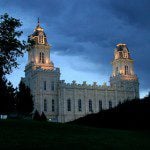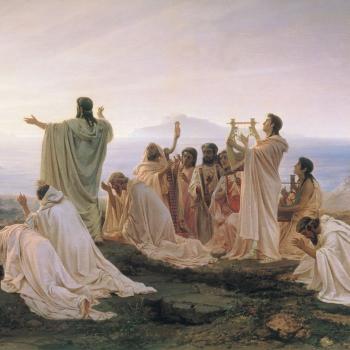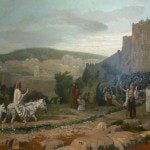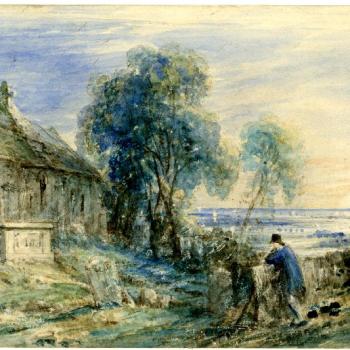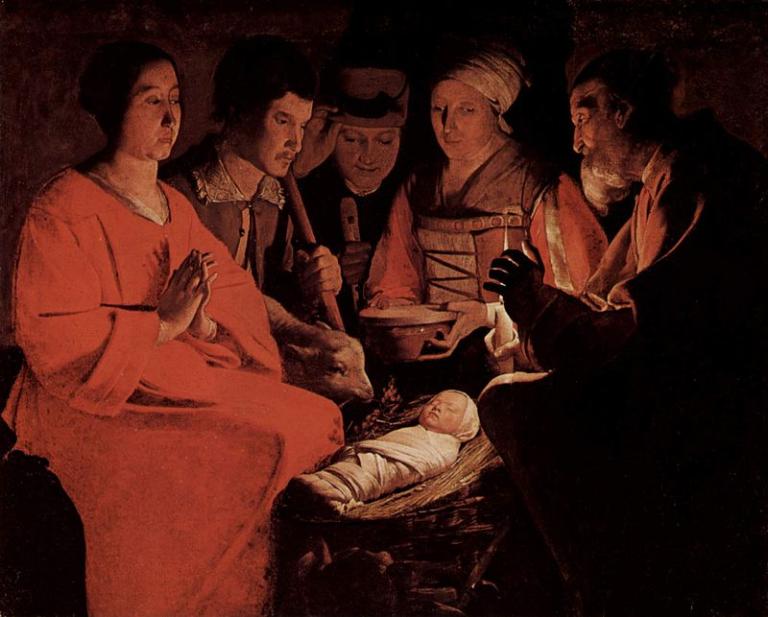
Wikimedia Commons public domain image
I wrote two newspaper columns for Christmas 2013. Here they are:
The first verse of the popular late-nineteenth-century Christmas carol “Away in a Manger” (often mistakenly attributed to Martin Luther) ends peacefully with “the little Lord Jesus, asleep on the hay.” Unfortunately, though, “The cattle are lowing; the poor baby wakes, but little Lord Jesus no crying he makes.”
Richard Mouw, the prominent Calvinist theologian who just completed two decades as president of California’s Fuller Theological Seminary, spoke recently at the LDS Institute of Religion adjacent to Utah Valley University. He pronounced the carol’s portrayal of an uncrying infant Jesus “heresy.” And he was right.
“Jesus was a real baby,” he reminded his large Mormon audience. “That baby cried.” “There was no Superman suit under those swaddling clothes.” Furthermore, Mouw said, the baby had no divine checklist that he was working through. (“Let’s see. Wise men? Check. Shepherds? Check. Hmmm. Could have designed that camel a bit better.”) So, said Mouw, when you come to this particular verse, “You should sing those words with your fingers crossed.”
He spoke humorously, but he was entirely serious.
Among the perpetual temptations in the history of Christianity has been the false doctrine of “Docetism,” from the Greek verb “dokeo,” meaning “to seem.” It is, simply put, that Jesus Christ was fully God but not, really, fully man. He only seemed human. He merely appeared to be subject to human limitations, pains, and weaknesses. But this would be worrisome, for, if he only pretended to take upon himself our nature, it’s not obvious how he could fully take upon himself our sins. If he didn’t really suffer, he didn’t really atone. He had to assume our human nature completely, or he wouldn’t be completely able to redeem it—and us. “God became man,” declares the ancient Christian formula, “so that man might become God.” St. Athanasius the Great, fourth-century bishop of Alexandria and a principal figure at the Nicene Council, put it this way: “The Word was made flesh in order that we might be enabled to be made gods. . . . Just as the Lord, putting on the body, became a man, so also we men are both deified through his flesh, and henceforth inherit everlasting life.”
Continuing, Professor Mouw cited the Book of Mormon. And, although frankly acknowledging that he doesn’t share the Latter-day Saint view of its origin and doesn’t consider it scripture, he cited Alma 7:11-12 with approval:
“And he shall go forth, suffering pains and afflictions and temptations of every kind; and this that the word might be fulfilled which saith he will take upon him the pains and the sicknesses of his people.
“And he will take upon him death, that he may loose the bands of death which bind his people; and he will take upon him their infirmities, that his bowels may be filled with mercy, according to the flesh, that he may know according to the flesh how to succor his people according to their infirmities.”
Quoting further, Mouw spoke of our common “faith on the Lamb of God, who taketh away the sins of the world, who is mighty to save and to cleanse from all unrighteousness” (Alma 7:14). “When it comes to the redemptive work of Christ,” he concluded, “we say the same things.”
But all of this depends upon the truth of the shared conviction that “In the beginning was the Word, and the Word was with God, and the Word was God. The same was in the beginning with God. All things were made by him; and without him was not any thing made that was made. In him was life; and the life was the light of men. And the light shineth in darkness; and the darkness comprehended it not. . . . He was in the world, and the world was made by him, and the world knew him not. He came unto his own, and his own received him not. But as many as received him, to them gave he power to become the sons of God, even to them that believe on his name” (John 1:1-5, 10-12).
On the basis of this common faith, Latter-day Saints join the great Christian chorus that extends across two millennia and around the globe, rejoicing in the advent of Christ, knowing that “the Word was made flesh, and dwelt among us” (John 1:14), “that God was in Christ, reconciling the world unto himself” (2 Corinthians 5:19).
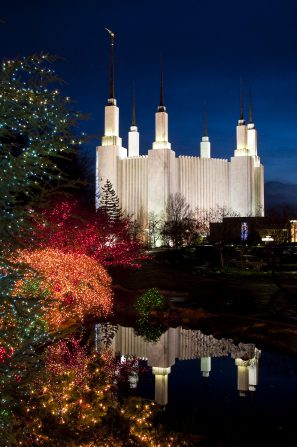
(LDS.org)
Many Western Christians observe a season called “Advent” (from the Latin “adventus,” or “coming”) during the month before they celebrate Christ’s Nativity at Christmas. Advent begins on the fourth Sunday prior to 25 December, and opens the liturgical year in the Moravian, Presbyterian, Methodist, Lutheran, Anglican, and Roman Catholic calendars. (Eastern Christian communions celebrate a rough equivalent of Advent called the “Nativity Feast,” but its role and function differ somewhat.)
Latin “adventus” is equivalent to the Greek term “parousia,” which commonly refers to Christ’s Second Coming. Not coincidentally, therefore, Advent celebrations typically anticipate his glorious return in addition to commemorating his birth in Bethlehem. Just as ancient Jews longed for the coming of the Messiah, modern Christians yearn for his Second Advent. For this reason, some theologians call Advent “the season of already/not yet.”
Advent isn’t biblical—the first plain references to it appear late in the sixth century—and it surely isn’t required for salvation. But then, the same can be said of virtually every one of our Western Christmas traditions. And, amidst the high-pressure commercialism and the rat race of contemporary Christmas observance (if that’s really the word for what our society does), it seems a pretty good way of preparing spiritually for what is, after all, a supremely spiritual and religious holiday (i.e., “holy day”). Various Advent candles, calendars, and wreaths are used to mark the season and to mark off its days as they pass, as are different colors (e.g., in candles and vestments)—notably purple, blue, and, sometimes, rose.
The ecclesiastical Latin hymn “Veni, veni, Emmanuel” is a metrical version, in seven verses, of part of the vespers or evening liturgy for the final week of Advent. Its origins are unclear, but the text goes back in some form or another to at least the twelfth century, and possibly to the eighth. It’s based on the prophecy in Isaiah 7:14, that God will give Israel a child symbolically called “Immanuel” (literally, “God with us”), which Matthew 1:23 says was fulfilled in the birth of Jesus. The music appears to come from a fifteenth-century processional hymn for French Franciscan nuns, although it, too, may have eighth century origins in a Gregorian chant.
The lyrics also echo a number of other prophetic themes. The “Rod of Jesse” refers to the prophecy in Isaiah 11:1 concerning the father of David and the Davidic messiah. The term “Dayspring” stems from a prophecy given by Zacharias, the father of John the Baptist, and recorded in Luke 1:78. The reference to the “Key of David” is inspired by Isaiah 22:22 (“the key of the house of David will I lay upon his shoulder”), which in turn refers to Isaiah 9:6 (“the government shall be upon His shoulder”).
In the nineteenth century, John Mason Neale and Henry Sloane Coffin translated this medieval liturgical hymn into English, as “O Come, O Come, Emmanuel”:
“O come, O come, Emmanuel, and ransom captive Israel that mourns in lonely exile here until the Son of God appear. Rejoice! Rejoice! Emmanuel shall come to you, O Israel!
“O come, thou Wisdom from on high, who ordered all things mightily. To us the path of knowledge show, and teach us in her ways to go.
“O come, thou Rod of Jesse, free thine own from Satan’s tyranny. From depths of hell thy people save, and give them victory over the grave.
“O come, thou Dayspring, come and cheer our spirits by thine advent here. Disperse the gloomy clouds of night, and death’s dark shadows put to flight.
“O come, thou Key of David, come, and open wide our heavenly home. Make safe the way that leads on high, and close the path to misery.
“O come, O come, great Lord of might, who to thy tribes on Sinai’s height in ancient times once gave the law in cloud and majesty and awe.
“O come, Desire of Nations, bind in one the hearts of all mankind. O, bid our sad divisions cease and be yourself our King of Peace.”
In the Roman Catholic Church, two verses of the hymn are sung each week of Advent, beginning with verses one and two on the first Sunday. On the second Sunday, verses three and four are sung and, on the third, verses five and six. Finally, on the last Sunday, congregations sing the first and seventh verses.
In their hope for Christ’s return, modern Christians echo the messianic dream of ancient Israel.



